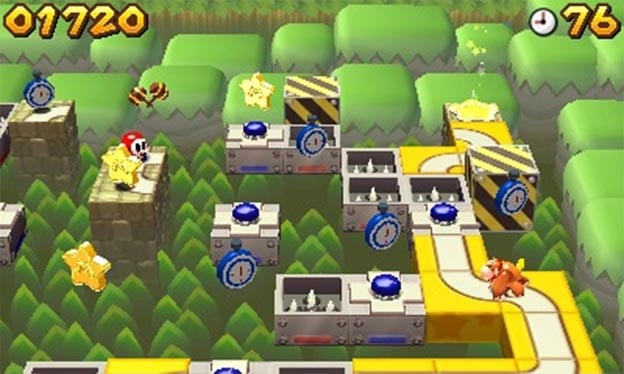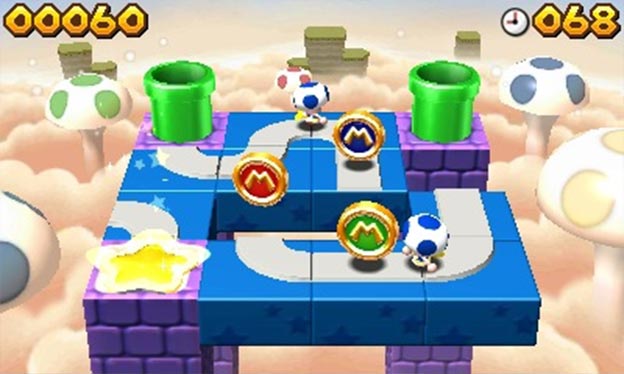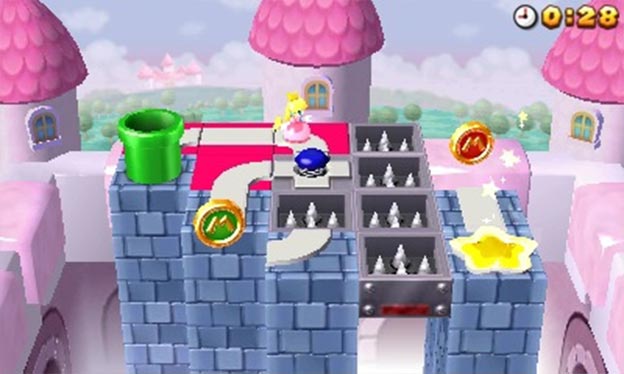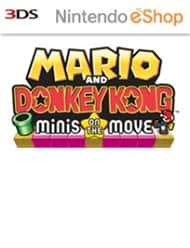Get All Wound Up
It’s hard to call the Mario and Donkey Kong (or Mario vs. Donkey Kong) games a series, as each one seems to feature completely different gameplay from the last. While the previous Mario vs. DK game was a Lemmings clone, Mario and Donkey Kong: Minis on the Move has completely different (and I’d argue superior) gameplay. It’s being released unceremoniously on the 3DS eShop, but don’t be fooled by its downloadable nature and low price. This is a full-fledged puzzler that puts most smartphone games to shame.
The game has four main modes, but all of them have a few basic principles in common. The player sees a top-down view of a gridded play area on the bottom screen, while a tilted 3D view shows up top. The goal is to build a track from straight and curved tile pieces that leads one or more wind-up minis from its starting point to a goal. Of course, it’s not that simple. The player must collect three M coins along the way to get full credit for the level. In addition, fixed path pieces, rotating curves, enemies, conveyer belts, leapfrog traps, and other obstacles stand in the player’s way.

The game contains four main modes. At first, the player only has access to Mario’s Main Event. In this mode, path tiles randomly (or semi-randomly in the case of some levels) fall into a cylinder at the side of the playing field. Players have to drag the fallen tiles with the stylus, placing them to create the proper path for a single mini without going over the level’s time limit or allowing the cylinder to overfill with tiles. Bomb tiles and “trash cans” assist the player with path management. Mario’s puzzles become more complex over time, and the player is presented with more traps and tools as puzzles are completed. These puzzles are the solid foundation on which the game is built, and are quite addictive.
The Puzzle Palace unlocks after the first ten Mario levels are complete. This mode has no time limit, but only gives the player a specific set of path tiles to work with. Unlike Mario’s Main Event, there’s usually only a single solution to Puzzle Palace levels. Unlike the other levels, in which the player is forced to connect the path to the mini’s starting spot after a short time, the player can build the entire path before the mini starts marching along. This is the section of the game that rewards careful planning over quick reflexes and the ability to improvise.

Many Mini Mayhem unlocks after ten Puzzle Palace levels are solved, and it tasks the player with guiding two or more minis to the goal. Sometimes the minis come out of the same starting point, and sometimes they spawn at different spots on the map. Instead of working with tiles from the side of the play field, Many Mini Mayhem requires people to slide tiles around the puzzle, collecting all the M coins and getting all minis to the end safely on a constantly shifting road. Players are challenged to keep their cool and devise swift strategies to keep all the pieces on the board.
Finally, the Giant Jungle unlocks after ten Many Mini Mayhem puzzles have been solved. These puzzles work like Mario’s Main Event, but are gigantic and feature strict time limits. The player must use strategy to collect more time while building a path through the levels, collecting stars in lieu of M coins in order to go for a high score. Players will want to complete twenty to thirty Main Event levels before attempting the Giant Jungle, because they will need to learn advanced path-building strategies before they’ll have a chance at surviving the Great Jungle.

These four different kinds of levels give the game a nice sense of variety, as each puzzle type has its own rules and pacing. Puzzle Palace is slow and thoughtful, Many Mini is frantic, Mario’s Main Event is in-between, and the Giant Jungle is a challenging area that builds on the skills acquired in the other puzzle modes. There are a ton of puzzles to solve in the game as a whole; enough to keep most players busy for quite a while. There are sixty puzzles each in Mario’s Main Event and the Puzzle Palace. Many Mini Mayhem boasts fifty puzzles, and there are three Giant Jungles to navigate.
Two things hinder the play value of the game somewhat: the levels in the first three modes don’t have much replay value, and players must solve every puzzle in each block of ten before they’re given access to the next set of puzzles. It would have been nice to give players the occasional ability to pass on that one darn puzzle that turns out to be a stumper, rather than doom the player to be stuck until it’s solved. In general, though, players will be having too much fun to get annoyed by these minor issues.
If the 173 included levels aren’t enough, there’s a collection of touchscreen controlled mini-games to play with. Players can use a slingshot to shoot mini-Marios at targets or use them to break up puzzle cubes. A fast-paced fishing game has the player luring Fly Guys out of the sky, and a final game has the player helping a mini-Mario on an elevating platform navigate a treacherous skyscape. There’s even a side mini-game in which the player can view and polish a miniature collection that is accrued by solving the puzzles in the four main game modes.
On top of all that, players can create new levels to share using the game’s included workshop. The player is given access to all the major tiles and traps found in the game, although as far as I could tell it’s only possible to create levels in the style of Mario’s Main Event. Puzzle creation is quite easy, though it should be noted that the player is required to successfully solve his or her own puzzle before the game allows it to be shared with the world.

It’s also quite simple to find new puzzles. There are no friend code shenanigans involved; players can browse all the puzzles that have been shared online or sort for puzzles by existing friends. This is one example of Nintendo getting online features completely right.
This impressive amount of gaming value for the price rests on a solid foundation in the graphic and sound departments. Graphics are crisp, clear, and cheery. Individual puzzle elements are immediately identifiable, allowing the player to concentrate on strategy rather than figuring out which pieces are supposed to do what. Puzzles are accompanied by pleasant remixes of classic Mario music. Sound effects are satisfyingly springy, as appropriate for a game that is basically a giant toy box for wind-up miniatures.
Nintendo’s Wii U may be foundering, but the company has been knocking it out of the park on the 3DS lately. Minis on the Move joins other greats like Pushmo to make the 3DS an amazing platform for anybody who enjoys a good puzzle game. Check it out, and prepare to get addicted to sliding tiles and frantically saving minis from a plunge into the dark abyss.
RATING OUT OF 5 RATING DESCRIPTION 4.0 Graphics
Nintendo’s graphics look great and do exactly what they should in a puzzle game like this. 4.0 Control
This fully stylus-controlled game is easy to control and offers a steady difficulty curve through its many puzzles. 3.9 Music / Sound FX / Voice Acting
Nice music remixes enhance the experience, and the sound effects reinforce the wind-up toy theme of the game. 4.5 Play Value
Few bargain-priced games have as much play value as this one, especially with the addition of player-made puzzles. 4.0 Overall Rating – Great
Not an average. See Rating legend below for a final score breakdown.
| Review Rating Legend | |||
|---|---|---|---|
| 0.1 – 1.9 = Avoid | 2.5 – 2.9 = Average | 3.5 – 3.9 = Good | 4.5 – 4.9 = Must Buy |
| 2.0 – 2.4 = Poor | 3.0 – 3.4 = Fair | 4.0 – 4.4 = Great | 5.0 = The Best |
Game Features:
